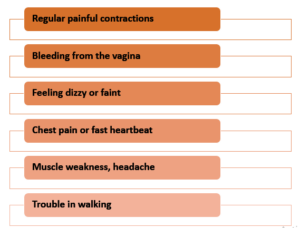There are usually many questions that come to mind when planning how to exercise during pregnancy. Maintaining a regular exercise routine throughout your pregnancy can help you stay healthy and feel your best. Physical exercise during pregnancy is important and can help with some common discomforts of pregnancy and even help prepare your body for labor and delivery. There is evidence that physical activity may prevent gestational diabetes (diabetes that develops during pregnancy), relieve stress, and build more stamina needed for labor and delivery.
Why is physical activity during pregnancy good for you?
There are several ways of performing regular exercise that is necessary for healthy pregnant women, regular exercise can:
- Keep the mind and body healthy. Physical activity can help you feel good and give you extra energy. It also makes your heart, lungs, and blood vessels strong and helps you stay fit.
- Try to maintain the right amount of weight during pregnancy
- Ease some common discomforts of pregnancy, such as constipation, back pain, and swelling in your legs, ankles, and feet
- Help you manage stress and sleep better. Stress is worry, strain, or pressure that you feel in response to things that happen in your life.
- Help reduce your risk of having a cesarean birth (also called c-section). Cesarean birth is surgery in which your baby is born through a cut that your doctor makes in your belly and uterus.
- Prepare your body for labor and birth. Activities such as prenatal yoga and Pilates can help you practice breathing, meditation, and other calming methods that may help you manage labor pain. Regular exercise can help give you energy and strength to get through labor.
What Exercises Are Safe During Pregnancy?
Most exercises are safe to perform during pregnancy, as long as you exercise with caution and do not overdo it. The safest and most productive activities are swimming, brisk walking, indoor stationary cycling, step or elliptical machines, and low-impact aerobics (taught by a certified aerobics instructor). These activities carry little risk of injury, benefit your entire body, and can be continued until birth.
Types of Exercise
1. Pelvic Floor Exercise
It is important to exercise the pelvic floor muscles during and after pregnancy to keep them strong. This can reduce the chance of leaking urine when you cough or sneeze (stress incontinence). It has been observed that doing pelvic floor exercises regularly can help to reduce the length of labor. One can exercise them at any time of day.
2. Strength Exercise
Strength exercises include working on the muscles harder than usual. They include yoga, tai chi, working with weights, walking uphill, and gardening. Additionally, dance, little bit of hill walking, heavy gardening, such as digging and shoveling helps to maintain the health of the pregnant women.
3. Cycling Sessions
Cycling is a great low-impact aerobic exercise but is not risk-free. It is safe to use an exercise bike at home, in the gym or as part of a group session. An aerobic activity is beneficial, which means that the heart, blood vessels and lungs all get a workout. It greatly helps in breathing deeply, experiencing increased body temperature, which will improve the overall fitness level.
4. Yoga
Yoga primarily focuses on mental and physical well-being. It uses a series of body positions (called postures) and breathing exercises. There are several pregnancy yoga classes, which use relaxation and breathing techniques with postures that are adapted for pregnancy. Furthermore, one should avoid classes that involve exercising in high temperatures.
5. Tai-Chi
Low-impact exercise known as tai chi involves gradual stretching and balancing motions. It improves balance, coordination, and leg strength. Before beginning tai chi, it is a good idea to consult the respective doctor.
6. Walking
Walking is an easy and safe way of keeping fit during pregnancy. One can do it for the whole 9 months if one feels comfortable. Walking is free and easy to fit into your daily life. Many times, it can be difficult for pregnant women to go to gym and perform exercise, in such cases, walking is a great option. It is the most comfortable sort of exercise for anyone, especially for pregnant women.
7. Kegel Exercise
The muscles that support the bladder, uterus, and bowels are strengthened by these activities. During pregnancy, one can strengthen these muscles and learn to relax and control them in advance of labour and delivery. They are also strongly advised during the postpartum period to improve perineal tissue repair, raise pelvic floor muscle strength, assist these muscles in regaining health, and improve urine control.
How much exercise do you need during pregnancy?
At least 2.5 hours of moderate-intensity aerobic activity are required each week for healthy pregnant women. Exercises that involve an aerobic component cause your heart rate and breathing rate to increase. You are enough active at a moderate intensity to perspire and raise your heart rate. A quick walk is an illustration of moderate-intensity aerobic exercise. If you find it difficult to speak normally while working out, you might be exercising too hard. Not all 2.5 hours have to be completed at once. Instead, divide it out over the course of the week. Do 30 minutes of exercise, for instance, most days or always. If this seems excessive, break up the 30 minutes into three 10-minute sessions of physical activity.
What kinds of activities aren’t safe during pregnancy?
Any activity that has a lot of jerky, bouncing movements that leads to fall, such as horseback riding, downhill skiing, off-road cycling, gymnastics or skating.
- Any activity that requires you to lie flat on your back (after the third month of pregnancy), such as sit-ups;
- Any activity in which you risk being struck in the stomach, such as ice hockey, boxing, soccer or basketball. Your uterus puts pressure on a vein that supplies blood to your heart while you lie on your back. Lying on your back can lower your blood pressure and reduce the amount of blood that reaches your unborn child.
- Activities like water skiing, surfing, or diving can result in you striking the water with a lot of force.
- Scuba diving or skydiving. Decompression illness can result from scuba diving. At this point, harmful gas bubbles start to form inside your infant.
- Working out at elevations greater than 6,000 feet, unless you already reside at a high elevation. The height of something above the earth is its altitude. For instance, you are most likely in the mountains if you are at a high height. High-altitude exercise during pregnancy can reduce the amount of oxygen delivered to your unborn child.
Warning Signs That You Should Stop Exercising
Exercising is good during pregnancy but too much exercise can also harm pregnant women. Here are the major warning signs that should be taken care of to pause exercising.

Conclusion
The more active and fit you are during pregnancy, the easier it will be for you to adapt to your changing shape and weight gain. There are some situations where you should check with your doctor before exercising. There is evidence that active women are less likely to experience problems in later pregnancy and labor. Most exercises are safe to perform during pregnancy, as long as you exercise with caution and do not overdo it. Women with certain conditions or pregnancy complications such as Cerclage, Placenta previa, Preeclampsia or pregnancy-induced high blood pressure, severe anemia and others should not exercise during pregnancy.

